
 |
| Home | Travaux STAF | Scenario for "How It Works?" - STAF15 | STAF-E |

 |
Contents Short Description of the Idea Short Description of the Idea  Target Public Target Public  The Scenario The Scenario  Goals of Activities Goals of Activities  Implementing Tools Implementing Tools  The Implemented Part of the Scenario The Implemented Part of the Scenario  References - Bibliography - Summary References - Bibliography - Summary |
 Short Description of the Idea
Short Description of the Idea
"How It Works?" is a multimedia project that aims at
explaining Physics and generally science of everyday life based on
Cognitive Flexibility Theory (CF). It will be a
laboratory where physics laws will meet with applications in real life
that people deal with almost everyday. But even though all of us know how
to use them, only few can explain how they work and why.
This project hopes to promote learning in that area. The idea is to start with
objects and look within them for scientific principles. However, this is
exactly the pattern in which much of science developed: people came to
understand many of natural laws by watching and studying the objects around
them.
It is an attempt to convey an understanding and appreciation for the concepts
and principles of physics and science by finding them within specific objects
of everyday experience. Many of these objects are interesting in their own
rights and their appeal will help to motivate studies of the scientific
principles that govern our universe.
My goals are:
So, the axes of exploitation will be:
| Axes of exploitation | ||
|---|---|---|
| Simulation | Theory (laws & formulas & units) | Glossary |
| Experiments | Check understanding | Study of similar objects |
| Exercises | References | Summary |
Below, is a list of some possible candidates for this exploitation :)
| Examples | |||
|---|---|---|---|
| Vacuum cleaners, | Airplanes, | Bicycles, | Elevators, |
| Thermometers & Thermostats, | Air conditioners, | Automobiles, | Xerographic copiers, |
| Computers, | Radio, | Television, | Microwave oven, |
| Lasers, | Cameras, | CD-players, | Plastics, |
| Nuclear Weapons, | Nuclear reactors, | X-rays, etc..... | |
 Target Public
Target Public The target public will be primely students of High School but also people that they aren't afraid to admit that they don't know "How It Works"...
But seriously speaking, if I would like to speak based on experiments
this multimedia instruction would be more effective to
low prior knowledge and high spatial students
(Interaction effects).
The rest, will just find it an amusing way of learning and that's all :)
 The Scenario
The Scenario
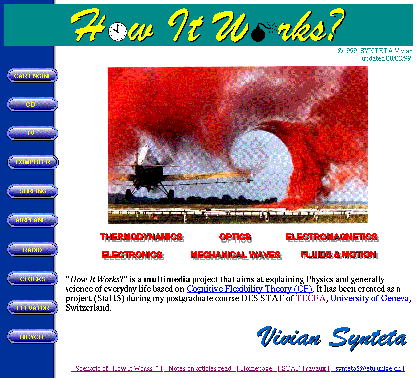 "Welcome page"
"Welcome page"
The learner faces a welcome page with the caption "How It Works?",
with a proper photo and underneath a short description of what exactly
is this welcome page for. There would be also two lists with a kind of buttons,
containing -the first one- the list with all the "machines" that are going
to be explained how they work and -the other one- with the relevant fields
of Physics. The aim of these two lists is to leave the choice to the learner
to choose his own way of exploration and find easily what he is searching for.
That means only that he is going to start learning in two ways:
 Introduction page
Introduction page
This, will be an extra motivation page with header a smaller gif image of
the project's title and next to it a big header that declares the name of the
machine the learner has chosen to explore, with three kinds of information:
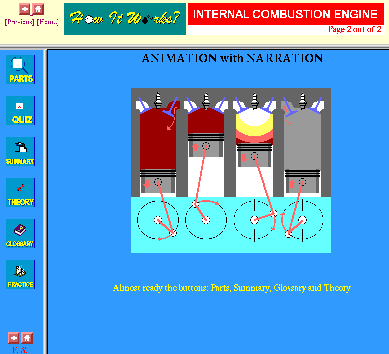 Exploration page - Activities
Exploration page - ActivitiesThis page, will have a header frame with a smaller logo of the project's name and a caption with the name of the machine to be explored. Exactly below the machine's name it will be mentioned the number of page he is looking at out of total so as to see immediately if there are any more pages to explore or not. Below this frame the rest of the window will be split vertically in two frames that each one will be an activity as below (Guided TCC):
|
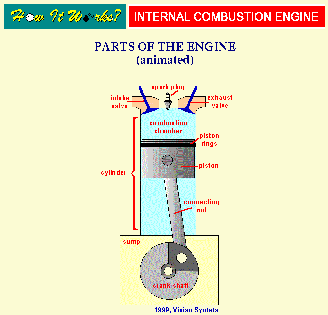 a Parts description. This activity presents an animated
image of the machine with a detailed description of all the
parts that is being made of.
a Parts description. This activity presents an animated
image of the machine with a detailed description of all the
parts that is being made of.
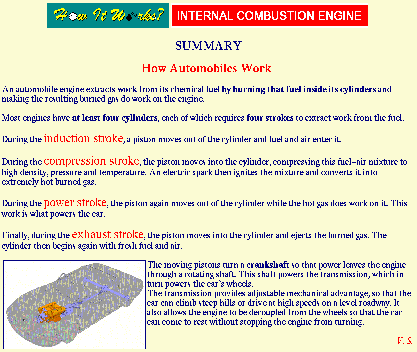 a Summary that places the explorating object on it's
proper background in science giving a more detailed
description of the phenomenon than the narration he listens
during the animation.
a Summary that places the explorating object on it's
proper background in science giving a more detailed
description of the phenomenon than the narration he listens
during the animation.
|
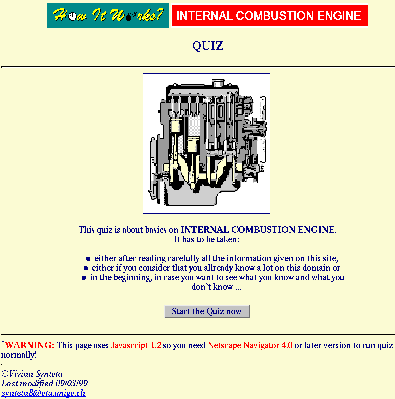
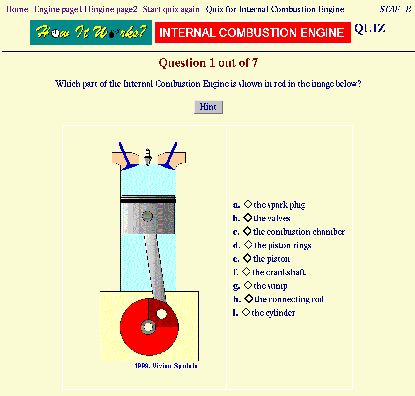 one or more problem solving transfer Questions
that can be a kind of an on-line quiz to test the
understanding of the learner with the proper feedback.
one or more problem solving transfer Questions
that can be a kind of an on-line quiz to test the
understanding of the learner with the proper feedback.Each QUESTION of the quiz will be presented at a time and the student's ANSWER will be immediately followed by the according FEEDBACK written in a new browser window with the possibility of having a HINT before receiving the final feedback. When he finishes the quiz, he gets a SCORE and some COMMENTS on his performance. Also the TOTAL number of hints used. he will also get a LIST of web sites or bibliography and articles to enhance learning of the domain. |
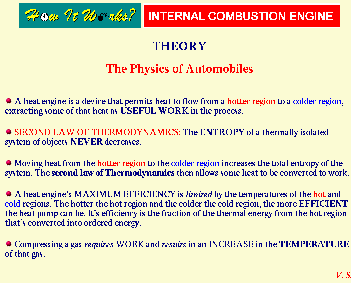 the relevant Theory in a way that will come normally
as a conclusion of all the above (the induction of rules
and the invention of models).
the relevant Theory in a way that will come normally
as a conclusion of all the above (the induction of rules
and the invention of models).
This, is because each student responds differently to the
equations. Like this, each one is likely to find one of these
three forms more comfortable, meaningful and memorable than
the others.
If there aren't any equations, like the implemented part of the
scenario, I will use colors and boldface and italics types of
characters to highlight the key words of theory. From my
short teaching experience, I have noticed that in that way
theory is much more easier to be remembered. It's a kind of
creating schemas.
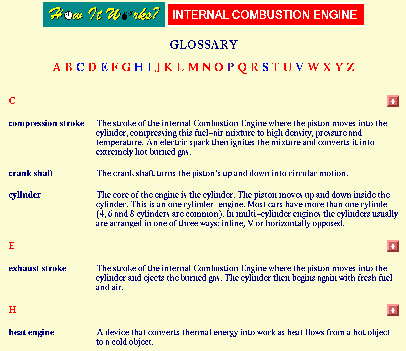 a Glossary with parts of the machine and scientific terms
involved, that the learner can go through at any time.
These key science terms will be marked in bold when they
first appear during the presentation.
a Glossary with parts of the machine and scientific terms
involved, that the learner can go through at any time.
These key science terms will be marked in bold when they
first appear during the presentation.
|

Each one of these sub-activities will open on a new window so as to have always in front the basic presentation except from the similar working objects that according to case will go to another similar page to the one already presented.
 Goals of Activities
Goals of Activities
First of all, I chose the multimedia presentation of this project because
a lot of studies have shown that multimedia instruction is extremely
effective (see Multimedia effect, R. Mayer).
Now, as far as it concerns the activities:
 Implementing Tools
Implementing Tools
The implementing tools will be HTML and Javascript.
I chose these tools even though I have used in the past Guide and
Toolbook, for the obvious reason (at least to me) that Web is a
very popular access to information nowdays and it seems to be the future of
hypertext and hypermedia if not the present :).
Graphics have been made with Top Draw, xv and
PaintShop Pro. Audio files were recorded with Sound Recorder of
Windows95 and wavrec of Linux. All HTML files have been written on
Emacs. I always work under Linux and only in exeptional cases
under Windows.
 The Implemented Part of the Scenario
The Implemented Part of the Scenario
I'm thinking of implementing the whole scenario focused on the exloration
of one machine that can be the prototype to implement later all the rest.
The most promising candidate seems to me to be the Internal Combustion
Engine of the car. (I have to admit that being grown up in a family with
father and brother car technicians there is a strong influence :)
In this example, I can easily integrate all of the above ideas for the
scenario.
You can have an idea of how it will look like
by Clicking here.
 References - Bibliography
(see summary)
References - Bibliography
(see summary)Jacobson M, Maouri C, Mishra P and Cohlar C.
(1995) Learning with Hypertext Learning Environments: Theory, Design and Research.
JI of Educational Multimedia and Hypermedia 4(4), 321-364. Read
Nathan M and Kintch W. and Young E.
(1992) A Theory of Algebra-World Problem. Comprehension and It's Implications for the Design of Learning Environments.
Cognition and Instruction 9(4), 329-389. Lawrence Erlbaum Associates, Inc. Read
Sweller J. and Chandler P.
(1991) Evidence for Cognitive Load Theory.
Cognition and Instruction 8(4), 351-362. Lawrence Erlbaum Associates, Inc. Read
Sweller John
(1988) Cognitive Load During Problem Solving: Effects on Learning
Cognitive Science 12, 257-285. University of new South Wales Read
Francoise Poyet
(1998) Formats de présentation et complémentarité modale dans les logiciels éducatifs
Sciences et techniques éducatives Volume 5 - no3, 245-262. Read
Mayer E. Richard
(1997) Multimedia learning: Are We Asking the Right Questions?
Educational Psychologist 32(1), 1-19. Lawrence Erlbaum Associates, Inc. Read
Louis A. Bloomfield
(1997) HOW THINGS WORK: The physics of everyday life
The University of Virginia John Whiley & Sons, Inc. Read
Cognition and Technology Group at Vanderbilt (CTGV)
The Jasper Experiment: An Exploration of Issues in Learning and Instructional Design Read
Simon St. Laurent
(1997) DYNAMIC HTML: A PRIMER
MIS press Refered
James Jaworski
(1997) Mastering JAVASCRIPT
SYBEX Refered
Daconta M., Saganich A., Monk E., Snyder M.
(1998) Java 1.2 and Javascript for C and C++ programmers
WILEY John Whiley & Sons, Inc. Refered
Marshall Brain
How Stuff Works! Explored
Informative Graphics Corp. (IGC) - Phoenix, Arizona
Automotive learning on-line - Automotive.com Explored
The Math Forum
Math Forum: Ask Dr.Math: FAQ Explored
John Li, Jeff Douglass, and Clay Cox
Under the hood Explored
CTGV
The Adventure of Jasper Woodbury Explored
Microsoft Encyclopedia
CD-Rom ENCARTA Explored